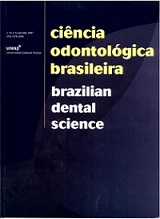Water interaction with dental luting cements by means of sorption and solubility
DOI:
https://doi.org/10.14295/bds.2012.v15i4.826Abstract
Water contributes to the setting reaction of self-adhesive luting cements, however, it can also accelerate their degradation. Objectives: The aim of this study was to compare a self-adhesive resin luting cement to other resin-based and glass-ionomer luting materials with regards to water sorption (WS) and solubility (WSB). The tested null hypothesis was that there is no difference in respect to these properties among the materials. Material and methods: Eight specimens from each group (15 mm x 0.5 mm) were prepared from self-adhesive luting cements Biscem (BC) and RelyX Unicem (R), dual-cure cements Bifix (BF), Allcem (A) and Enforce (E), chemical-cure cements C&B (CB) and Cement Post (CP) and a glass-ionomer luting cement Meron C (M) as the control group. The dual-cure products were light-cured beneath an IPS Empress Esthetic ceramic disk (20 mm x 1.5 mm) and for the chemical reaction materials, a 15 min-interval was respected for removal from the mould. The WS and WSB were respectively calculated as (m2-m3/V) and (m1-m3/V). Mass values of m1, m2 and m3 were determined by cycles of desiccation, water-immersion and a new desiccation. For each property, the data was analyzed by one-criteria ANOVA and Tukey tests (p < 0.05). Results: The glass-ionomer cement presented the highest WS, followed by the self-adhesive luting cements. Other resin cements were less susceptible to WS. No materials differed from each other when the WSB was considered, except for the M, which presented the lowest WSB. Conclusions: Self-adhesive luting cements were more prone to WS since water is essential to their setting reaction. However, their WSB was similar to the other resin-based cements.
Downloads
Downloads
Additional Files
Published
How to Cite
Issue
Section
License
Brazilian Dental Science uses the Creative Commons (CC-BY 4.0) license, thus preserving the integrity of articles in an open access environment. The journal allows the author to retain publishing rights without restrictions.
=================




























